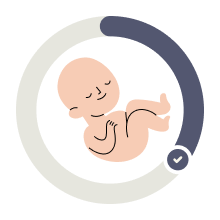As you hit the 40th week of pregnancy, you have finally arrived at the milestone that everyone has been eagerly anticipating. It’s possible that you’ll be welcoming your newborn baby this week, but if not, the end of your pregnancy journey is near. Despite the eagerness to deliver the baby, many individuals are caught off guard by the emotions that come with the reality of “the big day” when it arrives.
Pregnancy Week 40 Quick Facts
- At 40 weeks You are full term pregnant
- This is your third trimester
Your Unborn Baby’s Size at 40 Weeks
Welcoming Your Newborn into the World
After eagerly awaiting the arrival of your little one, the moment has finally come to meet your baby in person.
Physical Features
At birth, your newborn might not resemble the picture-perfect infants you often see in magazines. Those adorable, chubby babies typically grace the pages when they are a few weeks old. Right after birth, newborns appear wet and may exhibit signs of the birthing process they just went through.
The baby’s skull will be soft and flexible, allowing for a smoother passage through the birth canal. However, this can result in a temporary cone-shaped head if a vaginal delivery takes place.
Your newborn may still have remnants of vernix (a waxy, white substance that protected their skin in the womb) and lanugo (fine, soft hair that covered their body in the womb).
- Swollen eyes are common in newborns.
- Their hands and feet may display a bluish tint.
- The baby’s face or skin might have white dots, acne, or a red rash.
- The breasts and genitals of the baby may appear swollen.
- While your baby’s appearance may initially seem unfamiliar, these variations are normal and expected in healthy newborns. With each passing hour and day, your baby will gradually adopt a more polished appearance, as if ready for a magazine cover shoot.
Baby’s Post-Birth Tests and Procedures
Procedures and Tests After Birth
Skin-to-Skin Contact
Shortly after delivery, your healthcare provider will clear your baby’s airways, dry them, and place them on your stomach or chest for precious skin-to-skin contact—the first heartwarming hug. If immediate contact is not possible, it may be due to signs of distress or a C-section, in which case a pediatrician may need to evaluate your baby first.
Umbilical Cord
Your partner or healthcare provider will officially separate the umbilical cord, which connects your baby to the nourishing placenta throughout pregnancy.
Weight and Length
Measurements of your baby’s weight and length may be taken immediately after birth or delayed to allow for extended skin-to-skin time. These measurements will be repeated during subsequent pediatrician visits.
APGAR Score
Hospital or birth center staff will assess your baby’s skin color, heart rate, respiratory effort, muscle tone, and reflexes to determine their APGAR score. This evaluation is typically conducted one to five minutes after birth and can often be done while your baby rests on your chest.
Eye Drops or Ointment
Unless you decline, healthcare providers will apply erythromycin antibiotic eye drops or ointment to your baby’s eyes as a preventive measure against infection.
Vitamin K Injection
Usually administered within the first six hours after birth, a vitamin K injection is crucial for ensuring proper blood clotting, which reduces the risk of bleeding, including potential bleeding in the brain.
Hepatitis B Vaccine
The American Academy of Pediatrics (AAP) recommends administering the first dose of the hepatitis B vaccine to all newborns within 24 hours of birth. You will be asked to provide parental consent for this routine procedure.
Hearing Test
To assess your baby’s hearing, their ears will be exposed to sounds through headphones, while sensors placed on their head measure how well they perceive different tones.
PKU Test
The newborn screening test, usually done within 24 to 48 hours of birth, involves a small prick on the baby’s heel to collect blood samples. These samples are then tested for several illnesses such as phenylketonuria (PKU), galactosemia, and congenital hypothyroidism. The exact conditions tested for may differ depending on the state.
If You’re Awaiting Your Baby’s Arrival?
If you’ve reached the 40-week mark and your baby has yet to make their grand entrance, the best course of action is to practice patience. While it might not be the answer you’re hoping for, it’s essential to remember that babies follow their own timeline. In the meantime, there are a few things you can try to encourage your baby to assume the proper position and possibly stimulate labor
Taking walks
Engage in regular walks to keep your body active and encourage movement, which can help your baby shift into the ideal birthing position.
Nipple stimulation
Gently stimulating your nipples may release oxytocin, a hormone that can promote contractions. However, it’s crucial to consult with your healthcare provider before attempting this method.
Intimacy
Sexual intercourse, in some cases, can help kick-start labor. The prostaglandins present in semen may aid in cervical ripening, and the uterine contractions that occur during orgasm might help stimulate labor. It’s essential to discuss this option with your healthcare provider to ensure it is safe for you and your baby.
Remember, each pregnancy is unique, and there are no guarantees that these methods will initiate labor. Prioritize communication with your healthcare provider for personalized guidance and support during this waiting period.
What causes a baby to be overdue?
- There isn’t a single definitive reason why a baby may miss their due date. It could be due to familial factors, and you may have been born late as well. This may also happen during first pregnancies or if a prior pregnancy resulted in a late delivery.
- Some believe that a baby’s sex may also play a role, with boys being more likely than girls to arrive later. Additionally, discrepancies in the calculation of your due date may occur due to confusion regarding your last menstrual period. In such cases, the baby may not be overdue at all!
Developmental Milestones
Your baby is currently at 40 weeks, which is classified as “full term.” Infants born at full term typically have improved health outcomes and encounter fewer risks. Make sure to discuss with your healthcare provider if your baby has not arrived by 42 weeks.





